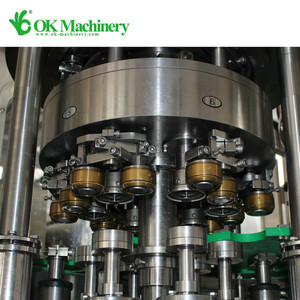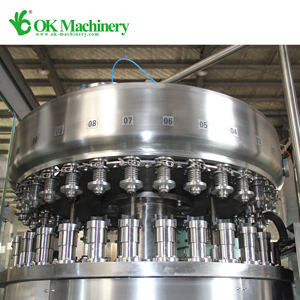
All categories
Featured selections
Trade Assurance
Buyer Central
Help Center
Get the app
Become a supplier

(12643 products available)


























Market Overview: The global market for beer can fillers is experiencing a transitional phase, influenced by shifting consumer preferences and market dynamics in the alcoholic beverage sector. According to Global Industry Analysts, the market for semi-automatic and manual filling equipment, which encompasses beer can fillers, was valued at approximately $3.9 billion in 2023 and is projected to reach $4.8 billion by 2030, reflecting a CAGR of 3.2%. This growth is particularly notable within the food and beverage application segment, expected to grow at a 4.5% CAGR. The U.S. market alone was estimated at $1.0 billion in 2023, indicating a robust demand for efficient filling technologies amidst a backdrop of changing consumption patterns in the beer industry.
Consumer Behavior Shifts: The craft beer segment in the U.S. has faced challenges, as consumer interest has shifted towards spirits and other flavored alcoholic beverages, with craft beer production peaking at 24.8 million barrels in 2021. This has led to a stagnation in traditional beer sales, pushing manufacturers to innovate and adapt their offerings. Furthermore, the online sales penetration for beer remains low at just 1.4%, compared to wine's 8.6%, indicating a potential area for growth in direct-to-consumer channels. As the market evolves, major players in the beer can filler industry must navigate these complexities, focusing on automation and efficiency to remain competitive while catering to the new consumer preferences for convenience and variety in the alcoholic beverage sector.
A beer can filler is an integral part of a canning line and is used to fill beer into cans. It is one of the essential equipment pieces required for packaging in the machinery industry. Depending on the production needs and canning line, beer can fillers can be designed in multiple ways.
Volumetric pressure fill
Beer is a carbonated beverage, and for it to retain its shelf life and quality, high levels of carbonation must be maintained. Vacuum and pressure fills offer a solution by filling the beer can with a specific volume, typically determined by the atmospheric pressure. This method is commonly used for carbonated beverages such as soda and beer. It is optional for each can to be filled with a different quantity. What distinguishes this type of beer can filling machine from others is its mechanism. The pressure at which the cans are filled is higher than the atmospheric pressure, which causes the cans to be filled to a predetermined level. These are usually automated machines that use overhead conveyors. They are popular choices for larger breweries or places with high demands for filling, as they have the capacity for faster production lines.
Vacuum can fillers
When the filling process begins, a vacuum is created inside the container, and the product is released into the container at the same level, resulting in uniform filling. This is a unique filling method for non-carbonated products such as still beer. This method focuses more on uniform filling of the product than on speed.
Manuel beer can filler
Manuel beer can filling machines are simple devices that require operators to hold and place cans on the filling nozzle. These machines can vary from stops to twenty hoses. Larger models may also include storage up to 600 cans. They are ideal for medium to low production lines and offer a cost-effective solution in this range. They require manual labor to operate and are good for home brewing.
Ipad canning machines
These machines are great for on-the-go canning. Whether breweries, distilleries, or hard seltzer producers are looking to can their products right at the source or just outside of it, these innovative machines provide a solution. They typically have a height-adjustable stainless steel frame with locking caster wheels. This ensures that the machine can be easily transported from one location to another with ease. The system may use standard, flat, or custom can ends to ensure compatibility with various canning requirements.
Counter-pressure filling
This process entails repressurizing the container's internal atmosphere. This approach helps reduce foaming during the filling procedure and is popular for carbonated products, including beer. Several factors, such as the filler design, transportation of the product gas, pressure equalization, can pressure drop, and the time taken for pressure equalization, determine the speed of canning lines. Larger breweries often use this method as it can accommodate higher speeds by changing the number of nozzles and reducing the time taken to equalize pressure.
Details of the beer can filler specifications may vary from model to model. Therefore, knowing the specifications when purchasing these beers is important to ensure that the needs of the buyers are fully catered to.
Filling Method
Beer fillers will generally vary by the method they use to fill beer cans. This will affect the speed and accuracy of the beer canning line. It is important to consider what kind of filling method would be ideal according to the needs of the business.
Capacity
This is how many cans the beer can filler can process in a certain period, which is often indicated in the model. Depending on the model, this capacity will vary from 10 to 80 cans per minute.
Circular or Pouch Speed
Depending on the model and type, the conveyer speed will vary. This speed will also impact how many cans per minute can be filled.
Cylinder Volume
This volume will determine how much beer can be filled in a single stroke, impacting the speed and efficiency of the filling process.
Compatibility
A range of beer can fillers is available for different sizes and types of cans, including standard 12 oz. cans and 16 oz. cans. It is also common to find machines compatible with any special or custom can designs.
Something important to consider when investing in a beer can filler is its maintenance. A properly maintained filler can ensure that it is functioning, maximizing its efficiency, and minimizing any downtime. When this is accomplished, it can ensure that the product of choice is being filled properly. It can also help the business save money.
Regular Cleaning
To avoid any build-up of beer residue or debris, it is important that the beer filler is cleaned regularly. This can be done while using sanitizing solutions or any damp cloth.
Lubrication
To avoid any build-up of beer residue or debris, it is important that the beer filler is cleaned regularly. This can be done while using sanitizing solutions or any damp cloth.
Inspection and Alignment
Components of the filler, like the centering device and can, should be seen regularly to ensure that they are aligned properly. This will ensure that there is the correct filling of the beer cans every time.
Software Updates
If the beer can filler comes with software, this should be updated regularly to ensure that any new features or enhancements are being utilized to their ability and potential.
Filling beer into cans is not only a preferred packaging option for breweries but also an application where beer can fillers find their primary usage. Nonetheless, it is worth noting that beer can fillers are used by breweries of different scales and industries.
Production volume requirements
Consider the brewery's production volume needs. Filler capability should align with the brewing quantity. Small, manual machines may suffice for low production, while high-capacity automatic fillers are better for large-scale brewing.
Filling accuracy and consistency
Opt for machines that provide precise filling and constant volume. This ensures that customers get the same amount of beer in each can, which helps the brewery maintain its reputation and avoid excessive wastage.
Can handling and flexibility
Think about how the machine handles cans and whether it can fill different sizes. Fillers that gently handle cans reduce the risk of damage and allow for quick changes to fill various can sizes as needed.
Ease of use and automation
Consider how simple it is to operate the filler and how automated it is. More automation can save time and effort, permitting workers to focus on other essential brewery tasks.
Cleaning and maintenance
Choose machines that are easy to maintain and clean. Look for features like quick-release components and accessible cleaning parts. This ensures that the machine will be adequately maintained, leading to dependable performance and consistent beer cans.
Budget considerations
Consider the budget for purchasing the beer can filler. While considering the initial cost, it is also essential to consider the long-term benefits, such as efficiency, reduced labor costs, and decreased product waste.
Q1: How does a beer can filler work?
A1: A beer can filler works by sequentially opening the can, pumping the beer into the can through a valve, and then closing the can. Some advanced models can also control the amount of foam generated while filling.
Q2: What types of beer can fillers are available?
A2: There are three main kinds of beer can fillers: vacuum fillers, pressure fillers, and gravity fillers. Pressure fillers are more commonly used in the beverage industry because they fill cans at higher speeds.
Q3: How much does a beer can filler cost?
A3: The price of a beer can filler depends on the type and size of the machine. Small beer can fillers can cost as low as $100, while large commercial beer can fillers can cost thousands of dollars.
Q4: What factors should buyers consider when buying a beer can filler?
A4: When buying a beer can filler, buyers should consider the machine's filling speed, accuracy, can compatibility, foam control, automation level, cleaning features, and size and space requirements.